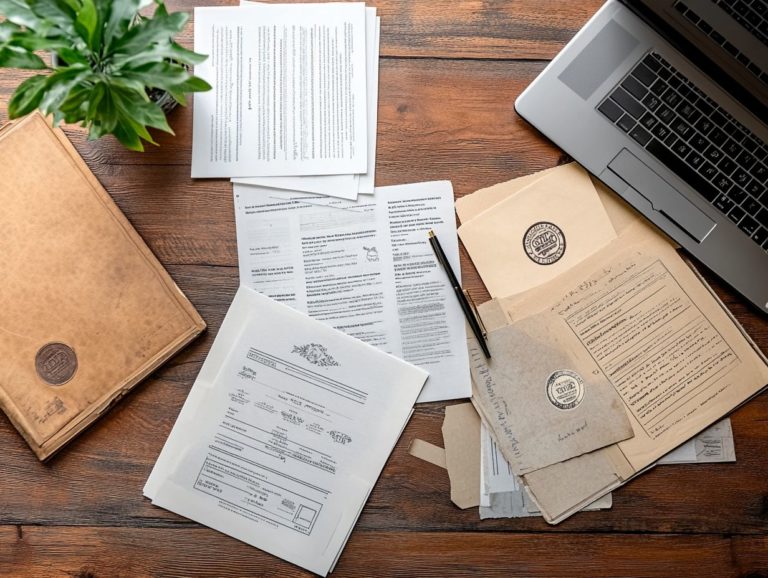How to File a Copyright Claim?
Copyright is a vital component of safeguarding your creative work in today s digital landscape. Many find themselves navigating the complexities of filing a copyright claim with uncertainty.
This article distills essential information for you, starting with a clear definition of what a copyright claim entails. It explores the various types you might encounter, including infringement claims and DMCA (Digital Millennium Copyright Act) takedown notices.
It guides you through the necessary steps to assert your rights. Plus, it provides valuable tips for effectively protecting your intellectual property. Whether you re a creator or a business owner, grasping these concepts is crucial for successfully navigating the intricate world of copyright.
Contents
Key Takeaways:

- Protect your creative work from unauthorized use by filing a copyright claim.
- There are two main types of copyright claims: infringement claims and DMCA takedown notices.
- To file a copyright claim, gather evidence of infringement, submit a DMCA takedown notice, and consider legal action if necessary.
Understanding Copyright Claims
Understanding copyright claims is crucial for you as a creator or copyright owner seeking protection for your original works. It requires navigating copyright law and the established processes set forth by the U.S. Copyright Office.
Copyright claims serve as legal assertions that you hold exclusive rights to a work of authorship. This can include literary pieces, musical compositions, visual art, or sound recordings.
These claims are essential in defending your rights as a copyright holder. They ensure that copyright protection is maintained across various contexts, including both commercial and nonprofit broadcasting.
What is a Copyright Claim?
A copyright claim is your formal assertion that you hold exclusive rights to your original works of authorship. This can encompass literary pieces, visual art, and sound recordings.
To file a copyright claim, you need to submit an application to the U.S. Copyright Office. For more detailed guidance, check out how to handle copyright infringement claims which outlines essential details, such as the title of your work and a deposit copy.
Originality plays a vital role in copyright law. Your work must exhibit a minimal level of creativity to stand apart from mere ideas or facts.
Under the Copyright Act, you enjoy a broad array of rights. These include the ability to reproduce, distribute, perform, and publicly display your work, as well as the right to create derivative works.
This legal protection not only enables you as a creator but also nurtures a thriving environment for artistic expression.
Types of Copyright Claims
Copyright claims encompass a diverse range of scenarios. They are typically categorized into infringement claims and DMCA takedown notices.
These categories are essential mechanisms for safeguarding the rights of copyright owners and addressing any violations that may arise.
Understanding these distinctions can enable you to navigate the complexities of copyright law effectively.
Infringement Claims
Infringement claims arise when a copyright owner asserts that their exclusive rights have been violated. This can lead to serious legal consequences for you, the infringer.
These claims can stem from a variety of actions, such as unauthorized reproduction, distribution, or performance of the copyrighted work. To successfully navigate an infringement claim, the copyright owner must prove several key elements.
These elements include their ownership of the copyright, the originality of the work, and evidence that you had access to the work. There must also be substantial similarity in how it was used without authorization.
Infringements can manifest in numerous ways, such as:
- Unauthorized file sharing
- Using copyrighted images without permission
- Plagiarizing text
These violations threaten the financial stability of the copyright owner. They risk losing potential revenue, and they expose you to legal consequences that could include statutory damages, injunctions, or even the burden of paying attorney fees.
It’s essential to understand the serious consequences you might face!
Ready to protect your work? Start your copyright claim today!
DMCA Takedown Notices

If someone is using your creative work without permission, a DMCA takedown notice can help you reclaim your rights!
DMCA takedown notices are formal requests made by copyright owners to online service providers. They ask for the removal of content that infringes on their copyrights.
The process usually starts when a copyright owner spots their creative work be it music, images, or text being used without authorization on a website or platform.
Once they’ve identified the infringement, they must craft a notice that includes essential details. This includes their contact information, a description of the original work, and a link to the infringing content.
To make the notice valid, it must feature a statement asserting a good faith belief that the content is indeed infringing. It should also include a declaration that the information provided is accurate and made under penalty of perjury.
Both the copyright owner and the service provider play integral roles in this system. They strive to protect the rights of creators while also considering fair use a legal term that allows limited use of copyrighted material without permission.
Steps to Filing a Copyright Claim
Filing a copyright claim requires you to navigate several essential steps:
- Start by gathering compelling evidence of infringement.
- Ensure your copyright is properly registered.
- Submit a DMCA takedown notice to protect your copyright rights.
Each of these actions is vital for protecting your creative work.
Gather Evidence of Infringement
Gathering evidence of infringement is crucial for you as a copyright owner. This reinforces your claim about the unauthorized use of your original works.
This process involves various methodologies. You can collect digital files showcasing your original work or capture real-time screenshots of the unauthorized use.
Witness statements can also enhance your case. They provide personal accounts detailing how the infringement was discovered and its impact.
Documenting your copyright ownership whether through registration or maintaining meticulous records of creation dates significantly strengthens your claim.
By consolidating these different forms of evidence, you can present a compelling case that underscores the seriousness of your situation.
Submit a DMCA Takedown Notice
Submitting a DMCA takedown notice is a formal process you can initiate as a copyright owner. It requests the removal of infringing content from online platforms.
This process is vital for safeguarding your intellectual property and ensuring you maintain control over your creative work.
When crafting a detailed notice, include key components such as:
- A clear identification of the copyrighted material.
- A description of the infringing content.
- Sufficient contact information for yourself as the copyright owner.
It s crucial to assert a good faith belief that the content in question is unauthorized. Fair use adds complexity because it allows some uses of copyrighted material without permission.
This means the outcome of your takedown notice may depend on the particular context in which the content is utilized.
Consider Legal Action
Consider legal action if your copyright claims aren t resolved through informal channels, particularly in cases of repeated violations.
Act quickly if informal resolutions fail, legal action may be your only option to protect your creative works and assert your rights.
There are various types of lawsuits you can pursue. This includes seeking damages for unauthorized use and obtaining injunctive relief to halt further infringements.
Engaging in legal action can become costly and time-consuming. Expenses like attorney fees and court costs can pile up.
That s why consulting with legal experts is essential. They can offer tailored advice and help you determine the most effective course of action.
Protecting Your Copyright

Protecting your copyright is essential for any creator or copyright owner. It requires proactive measures, including copyright registration and understanding copyright protection mechanisms.
Take charge now to protect your creative work effectively!
Preventative Measures
Implementing preventative measures is crucial for you as a copyright owner to shield your works from unauthorized use and potential violations.
By adopting strategies like watermarking your digital files, you can effectively deter misuse while enhancing recognition of your ownership. Displaying copyright notices prominently on your work acts as a clear warning to potential infringers regarding the rights that accompany your material.
Understanding the details of copyright fees tied to registration and the legal costs of enforcement enables you to make well-informed decisions. Regularly monitoring your creations for unauthorized use and staying updated on copyright laws will help you safeguard your creative output confidently.
Enforcing Your Copyright
Enforcing your copyright is a crucial step to ensure that your rights as a copyright owner are upheld, particularly in the face of potential violations. Proper enforcement protects your creative works and encourages respect for intellectual property.
To effectively protect your rights, consider employing strategies like sending cease and desist letters, which are formal requests to stop unauthorized use of your work, whether intentional or accidental.
Monitoring online platforms for possible infringements is essential. It allows you to act swiftly against unauthorized uses. In some cases, pursuing legal action may be necessary, serving as a deterrent to future violations.
Understanding these methods also highlights the potential legal consequences associated with infringement, such as hefty fines or court-ordered damages. This reinforces the importance of proper copyright management.
This video explains the importance of copyright protection and how to safeguard your creative works effectively.
Frequently Asked Questions
What is a copyright claim and why is it important to file one?
A copyright claim is a legal process used to protect original creative work from being used or reproduced without the author’s permission. Don’t wait! File your copyright claim to protect your work now.
Who can file a copyright claim?

The original creator or owner of the work is typically the only person who can file a copyright claim. However, if the creator has signed over their rights, then that individual or company may file a claim on their behalf.
How do I know if my work is eligible for copyright protection?
According to the U.S. Copyright Office, any original creative work fixed in a tangible medium, such as a book, photograph, or song, is eligible for copyright protection. This includes both published and unpublished works.
What steps should I take before filing a copyright claim?
Before filing a copyright claim, it is important to gather evidence of your ownership, such as drafts, timestamps, or registration with the U.S. Copyright Office. It is also recommended to consult with a lawyer or legal professional for guidance on the process.
How do I file a copyright claim?
To file a copyright claim, complete and submit a copyright registration form to the U.S. Copyright Office. You can do this online or by mail. The form will require basic information about yourself and your work, along with a copy of your original work. For detailed information, check out the steps to register a copyright.
What happens after I file a copyright claim?
After filing a copyright claim, the U.S. Copyright Office will review your application and determine if your work is eligible for copyright protection. If approved, you will receive a certificate of registration, which serves as legal evidence of your copyright ownership. You can then take legal action if anyone infringes upon your copyright.
Protect your creativity today! Start your copyright claim process now.






